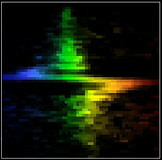![]()
A spectrograph spreads out the light gathered by a telescope so that it can be analyzed in order to find out many different things about celestial objects. These things are known as properties and they include the chemical composition and abundance of different elements, temperature, radial velocity, rotational velocity, and magnetic fields. The Space Telescope Imaging Spectrograph (STIS) can study objects across a spectral range from UV light (115 nanometers) through the visible red and the near-infrared light (1000 nanometers).
STIS uses three detectors: a cesium iodide photocathode Multi-Anode Microchannel Array (MAMA) for light from 115 to 170 nanometers (nm), a cesium telluride MAMA for light from 165 to 310 nm, and a Charge Coupled Device (CCD) for light from 305 to 1000 nm. The main technological development in STIS is its ability to perform two-dimensional rather than one-dimensional spectroscopy. For example, it is able to record the spectrum of many locations in a galaxy simultaneously, rather than observing one location at a time. STIS can also record a broader span of wavelengths in the spectrum of a star at one time. As a result, STIS is much more efficient at obtaining scientific data than other spectrographs used on other satellites.
This image was captured by Hubble's STIS. The colourful zigzag is the signature of a black hole suspected to exist in the M84 galaxy.
